Sharon Wolf
It’s Yours for Free!
A Look at Mid-Century Advertising Postcards
Offers of free gifts for motivating customers to become involved with a product or brand is not the invention of internet advertisers. Advertising postcards have been around since the start of the postcard era in the early 1900s. During the 1950s and 1960s, postcards offering free gifts were a very popular as a “business-to-customer” method for sales communications. The emergence of full-color Kodachrome printing processes (“Chromes”) enabled advertising card images to be crisp, colorful, and bright.
Retailers’ offers of free gifts were a popular sales tool for building business during the mid-20th century. The gift was shown in full color on the face of the postcard. The back of the card usually describes the product as well as explains how to redeem the gift. These household accessories were typically promised to customers as a “reward” or thank you for opening, re-opening or adding to their retail accounts. Before the era of debit or credit cards, people could deposit money for future purchases in store accounts. Think of this arrangement as a store-specific savings account. Alternately, they could establish credit at individual stores by opening up credit accounts for their purchases which could be paid off over time with interest. These financial arrangements enabled customers to buy expensive items that they otherwise couldn’t afford such as gold jewelry for a birthday or anniversary or wall-to-wall carpeting for their new suburban homes.
Businesses as diverse as banks, jewelry stores, carpet companies, gasoline stations and clothing stores all mailed free offer advertising postcards to their prospective and current customers. Interestingly, the household accessories that these stores offered typically had no relation to their own line of business.
During the mid-1950s and through the early 1960s, the post-World War II generation were getting married, buying homes with Veteran’s Administration loans and starting families. At the same time, they were striving to move a step up on the social ladder – usually from working class status to the middle class.
Decorating the home with new furniture and stylish household accessories was a way to communicate to friends and family that “we are making it and moving up.” The chance to have desirable products for the home without having to pay for them proved to be very appealing to homemakers during the ‘50s and early ‘60s because they were both budget-conscious, having come of age during the Great Depression, and also status-conscious. Material goods displayed in the home signaled social status for many Americans.
Mid-century marketers knew that their customers wanted to be stylish on limited incomes. For this reason, they gave away items that homemakers would consider to be luxuries, not necessities.
Next are descriptions and images of some of these advertising cards. Often, small print on the back of the cards explained the strings that were linked to the free offers such as minimum purchase requirements or a commitment to visit the store.
The “FREE – Our Gift to You!” advertising postcard offers a “7-Piece Aluminum Canister Set” with a testimonial on the front of the card: “It gave my kitchen a new look.” During World War II, products made of aluminum were generally not available to consumers because this metal was needed for the war effort. After the war ended, however, aluminum was once again available. Products made of aluminum were highly valued and perceived as “modern” by homemakers. The reverse side of this postcard promises “Yours Free…Just for Re-opening or Adding to your Account (with any purchase of $5.00 or more).”
Kranich Brothers jewelry store in Worcester, Massachusetts.
The Merry Chefs Ceramic Ensemble is offered as a reward for coming to Kranich Brothers jewelry store in Worcester, Massachusetts. The design of this ceramic ensemble rates a 10 on my kitsch scale. The reverse side promised: “Bring this card for your FREE GIFT.” Below in small type is the minimum purchase requirement, “Just make a purchase of $15.00 or more.”
Floor Craft Carpet Company in San Francisco, California
Another category of free offers is “No Purchase Necessary” offers which were created simply to bring customers to the store – with the aim of having them become more aware of the store’s products. Floor Craft Carpet Company in San Francisco, for example, offers a free gift of a “Handsome All-Purpose Utility Dish.” The front side explains that this versatile dish can be used “as a Planter, Cigarette Container or Ashtray. Also perfect for nuts, mints and candy.” Hopefully, the recipients of this gift item didn’t use it as both an ashtray and a candy dish! The product’s design and the accompanying text qualifies it for a 10 on the kitsch scale.
Sterling Jewelers of Hartford, Connecticut
The decorative, colorful bathroom towel “ensemble” manufactured by the well-known textile company, Cannon, offered homemakers a chance to have 15 stylish towels, instead of ordinary white ones. On the reverse side, Sterling Jewelers of Hartford, CT enticed customers to qualify for the gift by pointing out that “…the De Lux Matched Ensemble comes in the latest mix-match decorator colors to blend with your color schemes.” This towel set can be “Yours Free … Just for Re-opening or Adding to our Account.” Sterling Jewelers offered this gift with the goal of bringing back lapsed and/or inactive customers.
Ben Katz Furniture of Troy, New York
Ben Katz Furniture of Troy, New York
Ben Katz Furniture of Troy, New York gave new and existing customers a chance to own a stylish and trendy aluminum beverage set, complete with 8 tumblers, a serving pitcher, and an ice bucket. No doubt the fact that the text points out that the set is made of “hammered aluminum” was intended to imply that craftsmanship went into the production of these mass-produced tumblers and their accessories.
Some customers would open or add to their accounts so that they could obtain high-value products for free — such as an 11-piece Casserole set or a 20-piece Royal Ruby Luncheon Set with service for four. Both sets are offered as a “thank you” from local retailers. During the 1950s and 1960s, fulltime homemakers would periodically invite friends and neighbors to luncheon get togethers. What better way to impress guests than serving the meal on ruby red dishes, accompanied by matching desert dishes, salad plates, and tumblers.
Shell’s Free Comb for your Glove Compartment
One of the earliest examples of free offer postcards in my collection predates the 1950s. Shell Gasoline’s “Free Comb” is postmarked on September 1, 1939 in Brooklyn, NY. This date represents a time when Americans still felt the effects of the Great Depression with its severe financial deprivation. In this context, an offer to receive a free plastic comb was intended to entice drivers to fill up at their local Shell Station instead of at a competitor down the street. The comb is branded with an imprint of the Shell name and is described as a handy item to keep in your glove compartment.
Taking a close look at the “free gifts” genre of mid-century advertising postcards reveals a lot about the material goods, dreams, hopes and aspirations of the emerging middle class in Post-World War II America.
Check out the “Advertising Chromes” section in dealers boxes the next time you attend a postcard show. You’re likely to find some topics and images that are meaningful to you and deserve to be collected.

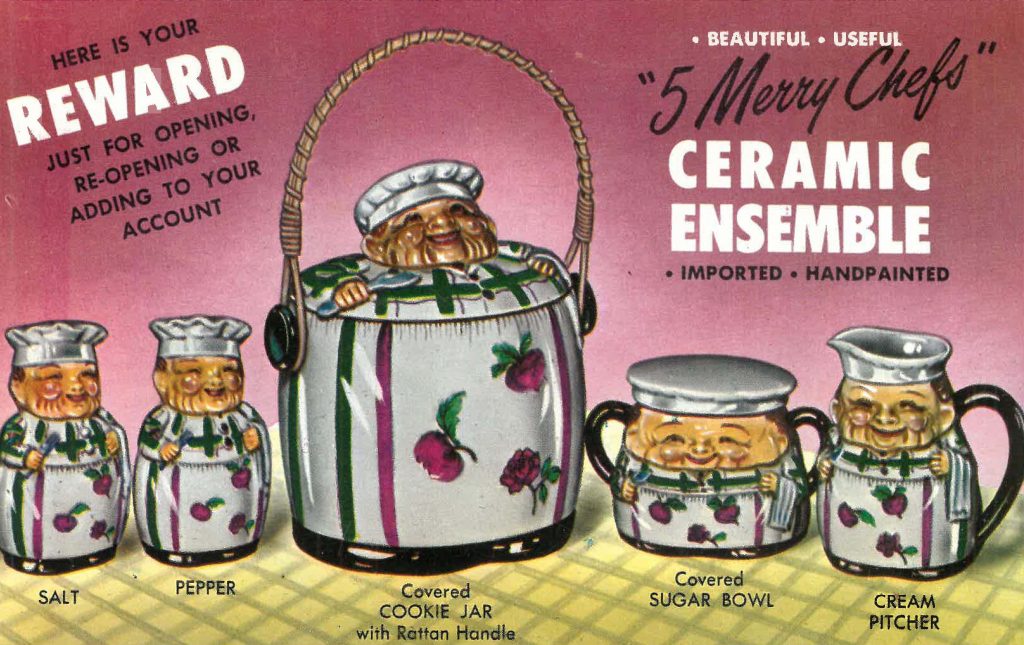
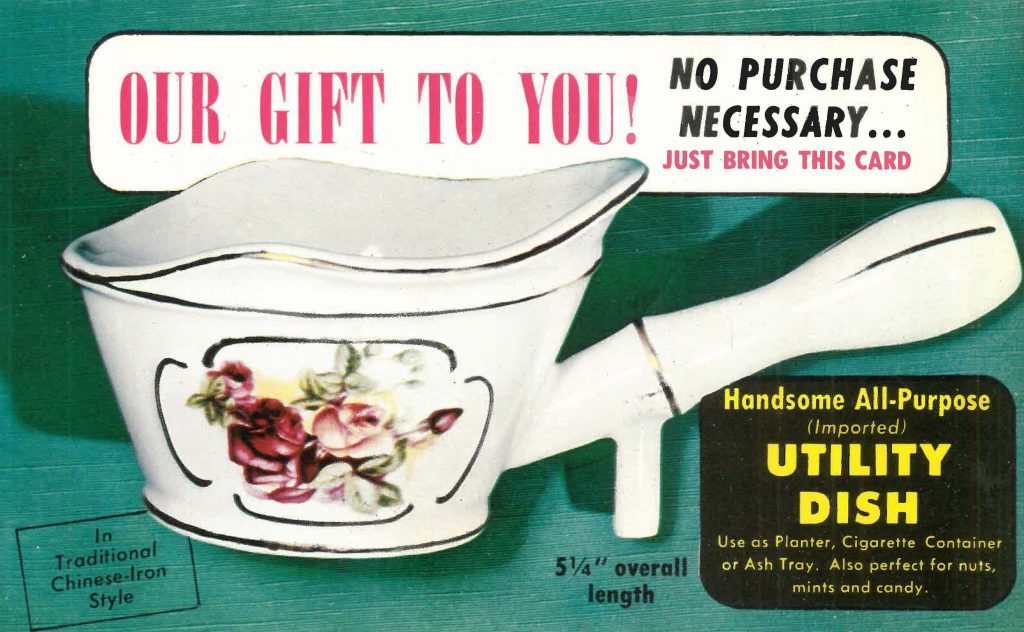
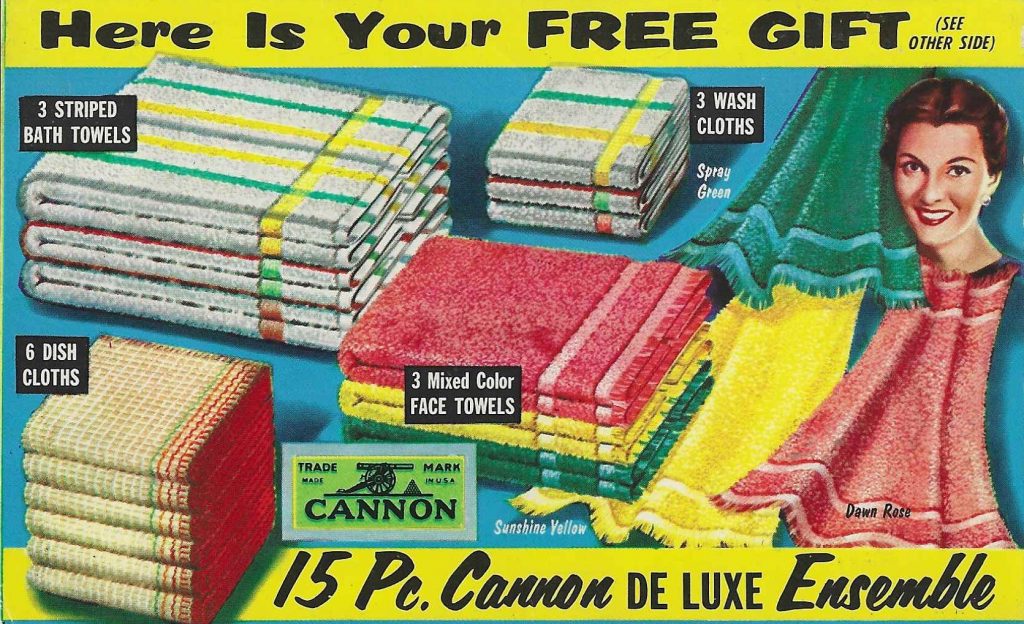
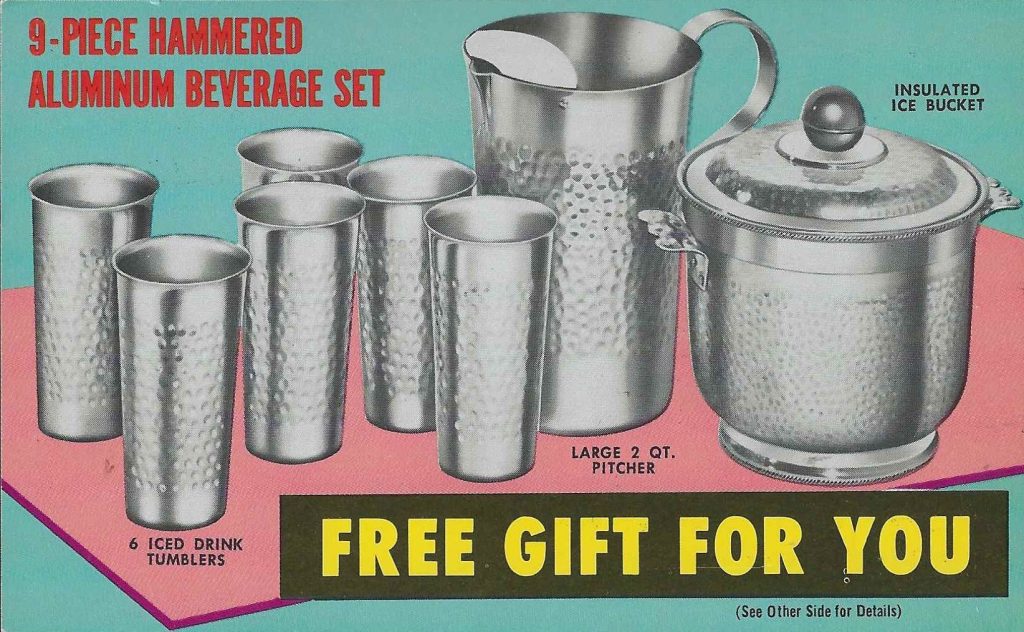
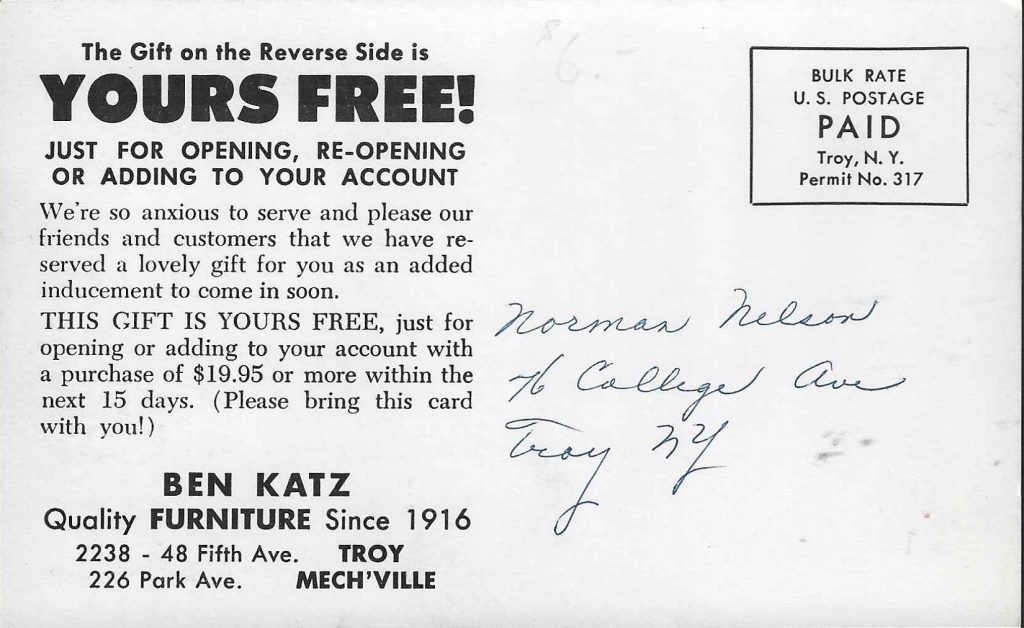
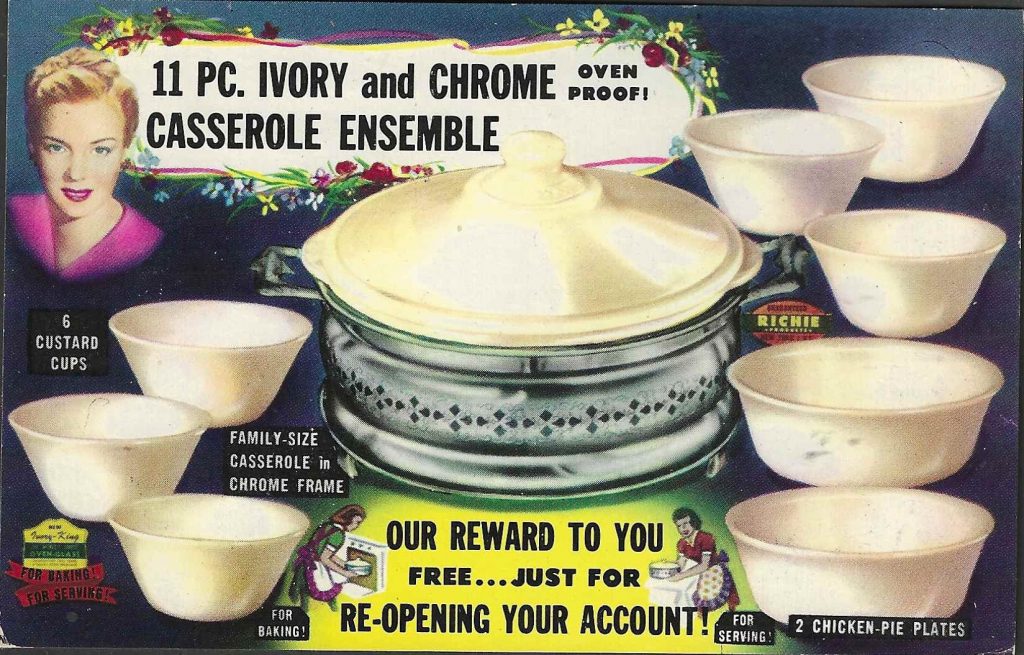
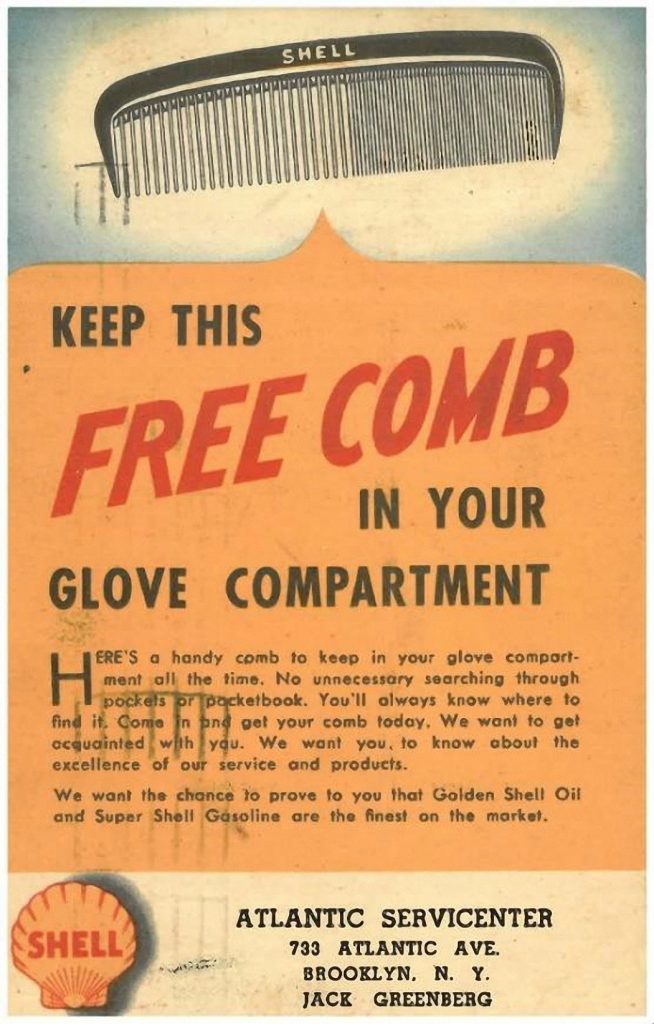
Wow… some cool items were offered… Very informative article…
Hi Peter – Thanks for letting me know that you enjoyed my article. Yes, some of the items offered for free are now collectibles and are pretty cool.
Thanks for the fun article and amusing postcards. I love mid-century kitsch!
Hi Anne-
I’m delighted to know that you found the article to be fun to read.
These days, we need some lighthearted info, Thanks for your feedback!
That grease container in the first postcard shown would have been an improvement over an old soup can!
Hi Bob,
Until you pointed it out, I didn’t notice the container for grease. Saving grease may have been a holdover from the Great Depression when buying cooking oil was a luxury for many folks.
It’s also possible that homemakers put Crisco in that container. In any case, agree with you – the grease can must have been considered an improvement over using empty soup cans.
Help! I hit the Rating Button by mistake and gave this article one Star. I thoroughly enjoyed the article and would give it Five Stars if I could figure out how.